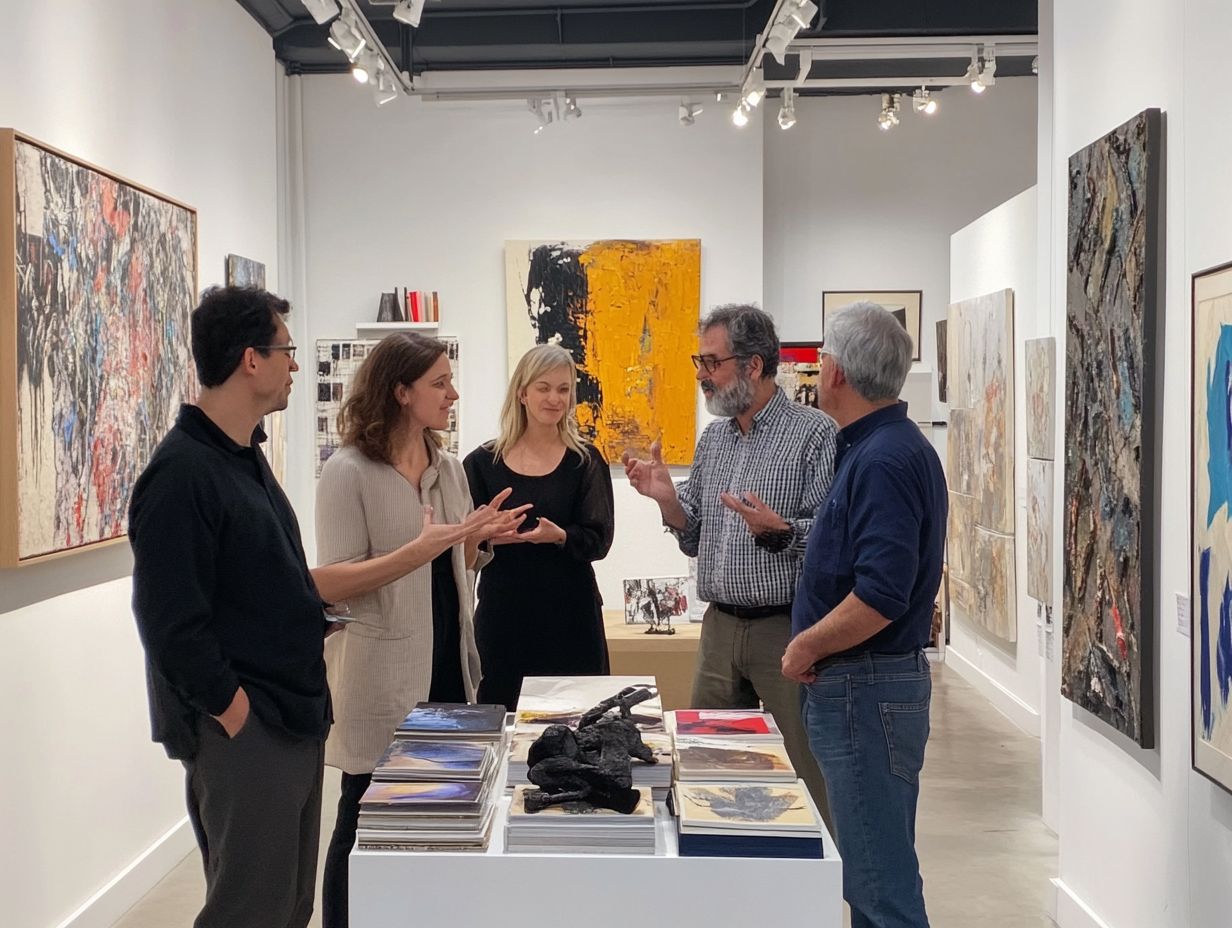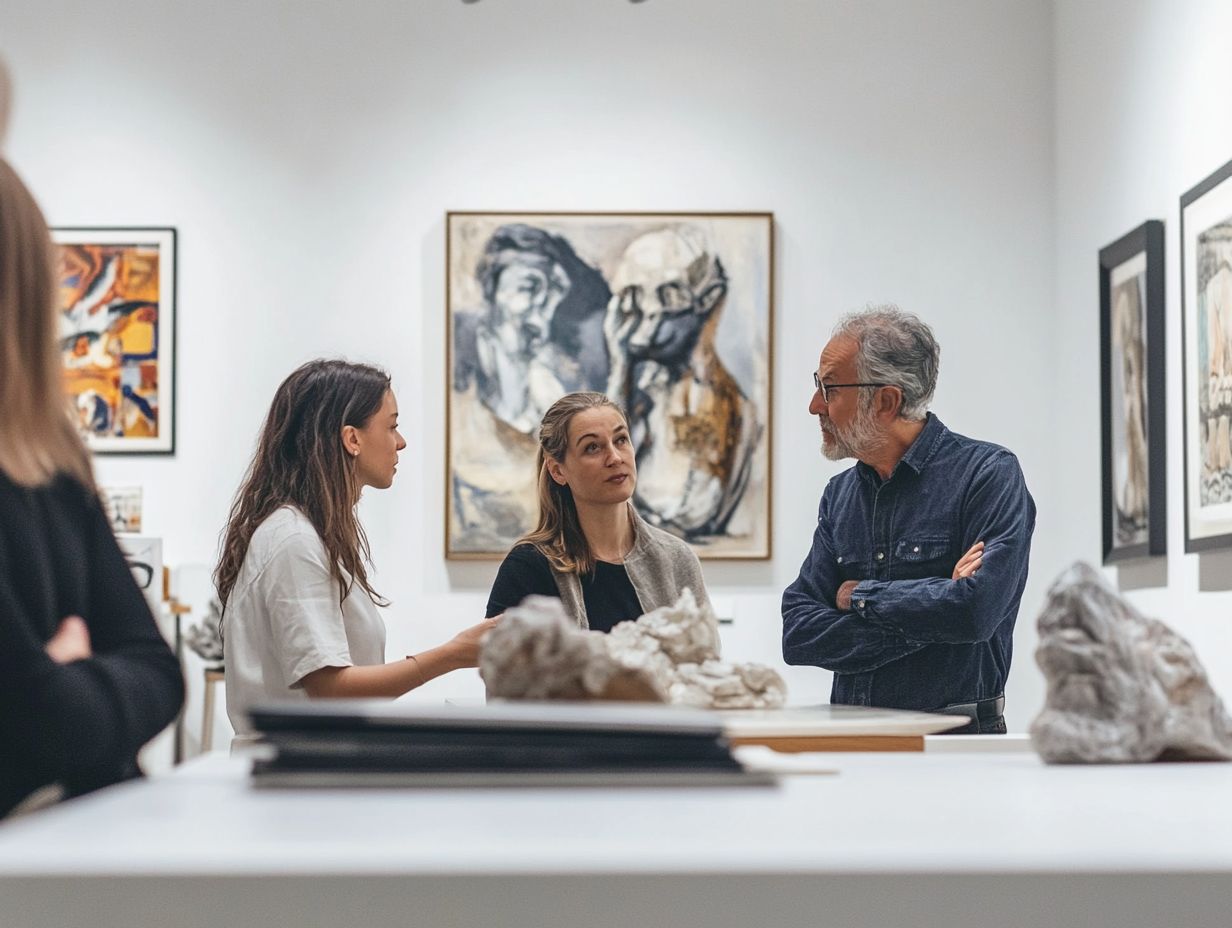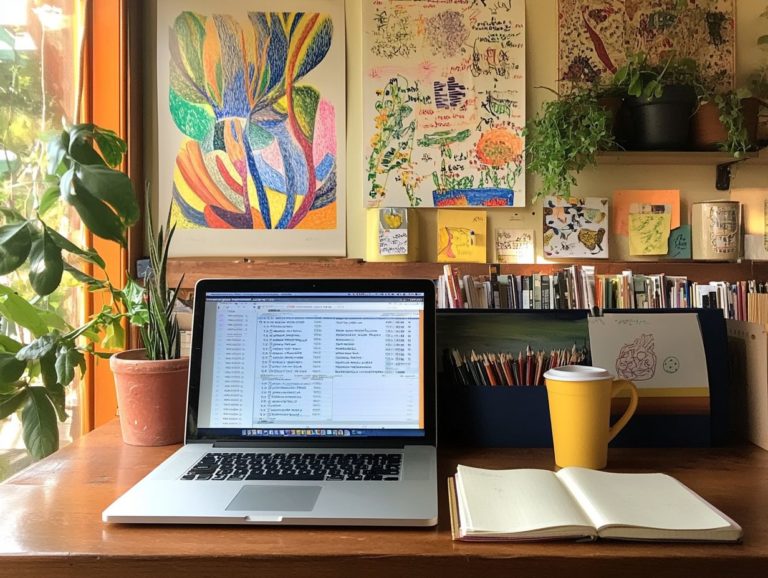Understanding the Art Market: A Collector’s Guide
The art market is captivating and complex. It attracts collectors, investors, and enthusiasts from diverse backgrounds.
This guide helps you navigate the key aspects of collecting art. You’ll define the market, identify key players, and delve into art valuation nuances.
Whether you’re considering your first purchase or enhancing an existing collection, understanding how to buy, sell, and preserve art is vital.
Join us as we reveal strategies and insights that will empower you on your art journey! Approach this captivating world with both knowledge and confidence.
Contents
Key Takeaways:

- Understand the basics of the art market.
- Learn to assess art value based on key factors.
- Familiarize yourself with buying, selling, auctions, and galleries.
The Basics of the Art Market
The art market operates as a sophisticated ecosystem, filled with diverse sectors and participants. For you, art investment presents a strategic opportunity to incorporate tangible assets into your portfolio.
This market flourishes due to the historical significance and emotional resonance of artworks, as well as its responsiveness to current trends and the financial potential of emerging artists.
To navigate this captivating landscape, grasp the dynamics within the art community, including the influential roles played by auction houses like Sotheby’s and Christie’s.
Defining the Art Market
The art market is a dynamic arena where artworks are bought and sold across various mediums and styles. Here, quality, rarity, emotional resonance, and investment potential from both established and emerging artists come into play.
This marketplace thrives through artists, collectors, galleries, auction houses, and art fairs, each significantly influencing trends and values. Understanding art offers insights into cultural significance and historical context, enhancing your connection to each piece.
As an art collector, you’ll often assess investment potential by evaluating factors like an artist s market trajectory, history of ownership (provenance), and current demand for specific styles or movements. This interplay among participants creates a vibrant ecosystem where passion and financial savvy intersect beautifully.
Key Players and Institutions
Key players in the art market include prestigious auction houses like Sotheby’s and Christie’s, galleries, individual collectors, and institutions all working together to shape the landscape of art investment and appreciation.
These establishments provide invaluable networking opportunities and professional guidance for both novice and seasoned investors. They don’t just facilitate buying and selling; they are essential in establishing provenance and authenticity, which are crucial for maintaining value in an ever-evolving market.
Galleries serve as vital venues where emerging artists can showcase their work, nurturing new talent and fostering meaningful connections within the community.
Individual art collectors often share insider knowledge and insights, enhancing everyone’s understanding of market trends.
Art consultants also play a significant role, advising clients on acquisitions and investments, enriching the conversation surrounding contemporary art, and expanding outreach through strategic partnerships and events that connect various sectors of the art world.
The Value of Art
The value of art is a rich, multifaceted concept shaped by various factors that determine the intrinsic worth of a piece. It includes the artist’s reputation, historical significance, the quality and rarity of the work, and the emotional resonance it holds for collectors.
These elements are crucial when you’re looking to invest in art, as they significantly influence both appreciation and market dynamics.
Factors That Determine Value

Several factors play a crucial role in determining the value of art. These include market demand, the artist’s reputation, emotional significance, and the quality and rarity of the piece. Each element contributes to its investment potential within the broader art market.
Market demand often shifts with current trends and consumer preferences. This can significantly sway pricing. For example, the resurgence of interest in contemporary artists like Banksy illustrates how public perception and cultural relevance can elevate a piece’s worth.
The artist’s reputation is another major factor in the valuation process. Works by renowned figures, such as Pablo Picasso, command staggering prices due to their established legacy. Emotional connections to artwork shaped by personal narratives or societal contexts also enhance its desirability.
Finally, consider the quality and rarity of a piece. Unique works by Vincent van Gogh create an aura of exclusivity, compelling collectors to invest in what is perceived as a one-of-a-kind masterpiece.
How to Assess the Value of Art
Wondering how to assess art value? It s easier than you might think! Assessing the value of art requires careful assessment of current market trends, emotional attachment collectors have to the piece, and expert insights grounded in a robust understanding of art history.
To embark on this journey, start with a thorough market analysis to explore comparable sales, illuminating the artwork’s potential worth.
Tapping into the expertise of art professionals such as appraisers or gallery owners offers invaluable perspectives that encompass both aesthetic and historical dimensions of the piece.
Considering the emotional significance that art holds for individual collectors can greatly influence its perceived value. Personal connections often amplify desirability.
Delving into unique features, provenance (the history of ownership), and the artist’s reputation is crucial for establishing a well-rounded valuation.
You need a strategic mindset to navigate the art market successfully! This involves understanding the roles of auction houses, galleries, and key events like art fairs and exhibitions. These insights can elevate your investment journey and unlock valuable market opportunities.
Buying and Selling Art
Buying and selling art requires a strategic approach that balances investment potential with a deep understanding of the motivations driving art collectors. Be attuned to the dynamics of auction houses and galleries within the art community.
Navigating this landscape means keeping a finger on the pulse of market trends and recognizing how specific pieces can appreciate in value over time. Engaging with experts art advisors, appraisers, and curators can provide invaluable insights into pricing, provenance, and emerging artists.
Attending art fairs and exhibitions allows you to connect with fellow collectors and gallerists, enhancing your negotiation strategies. Cultivating a keen eye for quality art while leveraging online platforms and art publications will help you stay informed and make educated decisions.
Understanding Auctions and Galleries
Understanding auctions and galleries is essential if you re looking to buy or sell art. These venues play a pivotal role in shaping market demand and pricing strategies within the art world.
They aren’t just transaction hubs; they serve as curators of culture, providing a vital backdrop for artists and collectors. Auction houses create a structured environment where bidding fosters a competitive atmosphere, often elevating an artwork s market value significantly.
Meanwhile, galleries function as both exhibition spaces and advocates for artists, helping to establish their reputations and influence public perception.
By keeping an eye on trends and shifts in buyer sentiment, you can make informed decisions that help you navigate the sometimes unpredictable art landscape. Ensure your investments align with current valuation trends to set yourself up for success in the art market.
Building and Maintaining an Art Collection

Building and maintaining an art collection is an enriching journey. It demands careful planning and a clear strategy.
As you select investment-worthy artists and ensure the quality of the art, you’ll find yourself immersed in the fascinating world of art conservation.
Each decision you make contributes to the depth and value of your collection. This transforms it into a true reflection of your passion and discernment.
Collecting Strategies and Tips
Effective collecting strategies require a keen eye for investment potential and a solid grasp of emerging artists.
Active participation in art exhibitions and fairs is essential. Staying informed about current trends and market dynamics further enhances your collection.
Prioritize thorough research and leverage social media platforms, which are invaluable for discovering new talent.
Engaging with online galleries can provide unique insights into new works and rising artists.
Networking at exhibitions allows you to build relationships with fellow collectors and curators. This can grant you exclusive access to artist studios and private viewings.
This personal touch deepens your understanding of the artist s vision. It makes it easier to identify pieces that resonate and hold potential for appreciation over time.
Preserving and Insuring Your Collection
Preserving and insuring your art collection is crucial for maintaining its quality and emotional value.
This protects your investment portfolio from unforeseen circumstances and potential damages.
Effective art preservation involves a range of effective methods, starting with establishing optimal environmental controls.
Regulating temperature and humidity levels is essential in preventing deterioration.
Utilizing proper framing and restoration techniques can significantly extend the life of your artworks.
Even with careful care, unpredictable incidents can threaten your cherished pieces.
This is where insurance becomes a wise choice. By securing adequate coverage, you safeguard your valuable items and gain peace of mind.
Frequently Asked Questions
Here are some common questions that many collectors ask!
What is the purpose of Understanding the Art Market: A Collector s Guide?
The purpose of this guide is to help collectors understand the art market and make informed choices when buying, selling, and managing their collections.
Who is this guide intended for?

This guide is for both novice and experienced art collectors who want to deepen their understanding of the art market.
It is also useful for anyone interested in starting their own collection or gaining insight into the art world.
What are some key topics covered in this guide?
This guide covers the history of the art market, the role of galleries and auctions, and the impact of technology on the market.
It also discusses strategies for buying and selling art, as well as the importance of careful research, art valuation, and storage and insurance.
Yes, this guide offers practical tips for navigating the art market. Researching artists, building relationships with galleries, and attending art fairs are key strategies.
It emphasizes setting a budget and seeking professional advice when needed, ensuring you stay informed about market trends and developments.
How Can Understanding the Art Market Benefit Collectors?
Understanding the art market has many benefits for collectors. It helps you make informed buying and selling decisions, avoid scams, and potentially increase the value of your collection.
It can truly enrich your experience as a collector. You ll also deepen your appreciation for the wonderful world of art!
Where Can I Find This Guide?
You can access this guide online through various art organizations, galleries, and auction houses. Some art bookstores sell hard copies, and many public libraries offer it for borrowing.






